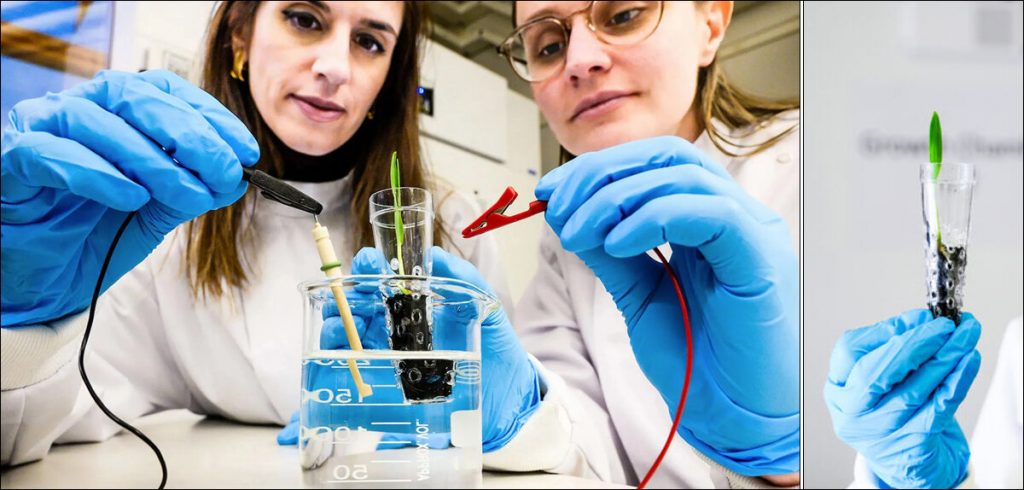The fact that two things (plants and electricity) that rarely interact with each other in nature except for lightning (which is rare) could have such an intricate relationship, is fascinating.
Hydroponic crop cultivation is the process of growing plants without soil and has become quite popular, especially in urban environments where there isn’t a lot of access to the sun or large open fields. Typically grown in soil-less mediums like lava rocks, perlite, clay pebbles, or coco peat, scientists have now come up with another medium, or novel conductive cultivation substrate, ideal for hydroponics. While that may sound like a mouthful, the easy way to say it is electronic soil (or e-soil), named after its ability to stimulate the root system of plants with low-powered electric currents. Why would you want to stimulate plants with electric current? Well, for a 50% boost in crop growth for starters, according to the study.

Electro-culture farming
While electro-culture may be a relatively new form of cultivation for some, a lesser-known fact is that it has been around since before the 18th century. That’s right, the ancient Japanese knew that mushrooms would grow wild around areas where lightning had struck though it was hard to replicate this before the invention of electricity. Once we did have electricity, however, electro-culture was mostly about delivering high voltage (like lightning) to plants to increase yields like with mushrooms. Pierre Bertholon de Saint-Lazare, a French physicist and philosopher built a contraption in 1746 that harnessed atmospheric electricity to mimic the effects of lightning and deliver electrical current to two garden pots with myrtle flowers which he claimed bloomed quicker, and with brighter blossoms.
While this high-voltage method of farming was mostly dismissed as quackery for a long time, a low-voltage version of electro-culture farming is quickly being recognized as a great way to increase yield in a hydroponic system. The concept here is that plants are responsive to low voltage electrical stimulation (in a good way) and that it not only promotes growth but also supports higher germination rates, as well as nutrient uptake. There are two main advantages of this type of electro-culture farming in addition to the increased yields, one is the increased nutritional value of crops due to the increased uptake of nutrients and minerals, and the second is the reduction in the need for fertilizers and other chemicals!
e-Soil
That’s right, electric current can substitute for chemical fertilizers which deplete the soil of nutrients and require re-application every season, some even go so far as to call it electrical manure. That’s the idea behind the e-soil developed by researchers at Linkoping University in Sweden. Unlike previous electroculture research that mostly focused on high-voltage root stimulation (mainly because soil isn’t very conductive), e-soil is conductive and requires very low voltage in order to stimulate the roots of a plant effectively. Additionally, while other options do exist for hydroponic electroculture (like mineral wool), they’re typically energy-intensive to manufacture and non-biodegradable. E-soil, on the other hand, is made mostly of cellulose, the most abundant biopolymer that easily biodegrades with the action of microorganisms!
The team of researchers, led by Eleni Stavrinidou, used a blend of cellulose and a conductive polymer called PEDOT. They then tested their e-soil on a test group of barley seedlings against a control group that did not have the e-soil. The difference was quite astounding and the test group exhibited a 50% growth spurt in a timespan of just 15 days when compared to the control group of seedlings. While Eleni Stavrinidou isn’t pretending like she understands the biological mechanisms that are taking place which is clear from her statement, “We don’t yet know how it actually works, and which biological mechanisms are involved,” she goes on to explain that what they do know is that the e-soil helps the seedlings process nitrogen more effectively.

The future of hydroponics
With the world’s population expected to reach 9.5 billion by 2050, current farming techniques are going to find it hard to meet the growing food demand. With climate change continuing to be a threat to global food security, a lot of people believe growing food in controlled conditions like hydroponics could be the answer. That being said, a 50% increase in growth is a major breakthrough even if it has only been tested on barley so far. In conclusion, irrespective of whether e-soil could be the answer to the global food crisis, it is definitely interesting from the perspective of a consumer, as well as a farmer. The fact that two things (plants and electricity) that rarely interact with each other in nature except for lightning (which is rare) could have such an intricate relationship, is fascinating, to say the least.
In case you missed:
- This Fuel Cell Lasts Forever and is Powered by Dirt!
- Scientists gave a mushroom robotic legs and the results may frighten you
- A Glowing Plant Could Be Your New Night Lamp for $29
- Bacteria That Can Generate Electricity from Wastewater!
- Researchers develop solar cells to charge phones through their screens
- This computer uses human brain cells and runs on Dopamine!
- The Latest Breakthroughs in Quantum Computing
- What’s Nvidia doing in the restaurant business?
- How AI Is Helping Restore the World’s Coral Reefs
- South Korean firm develops drone that flies on hydrogen fuel









